Bread packaging comes in many forms, each designed to keep your bread fresh while meeting different needs. From the common plastic bag to specialized vacuum packs, the right packaging can make all the difference in how long your bread stays soft and delicious.
Polyethylene Bread Bags (Twist-Tie Bags)
Polyethylene bags with twist ties are the most common bread packaging you’ll find in grocery stores. The bags work by creating a moisture barrier that keeps bread soft for 5-7 days. They’re made from food-grade plastic that’s 1.5 to 2 mils thick.
Most bags come with either plastic or paper-covered wire twist ties. Some brands use plastic clips instead, which are easier to reuse.
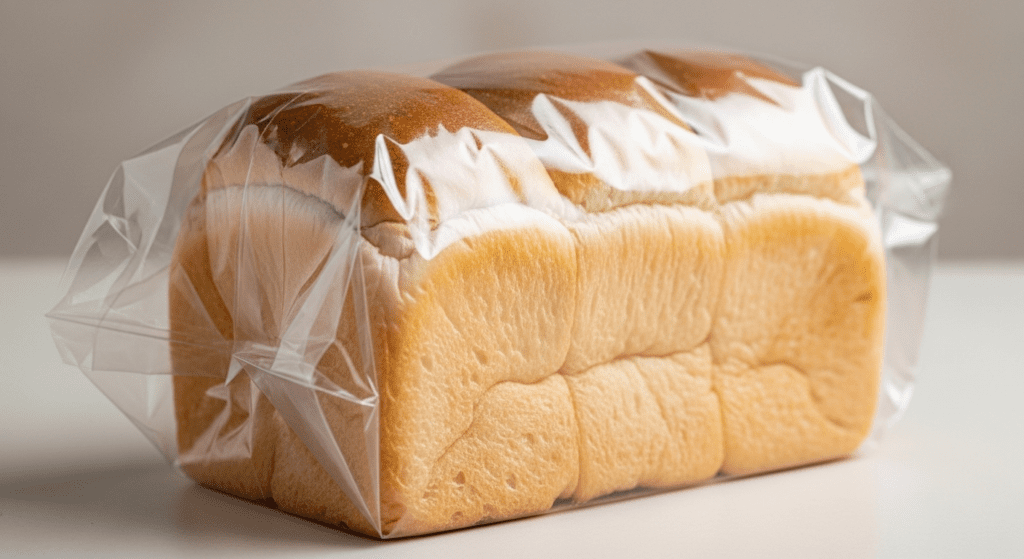
Flow-Wrap / Film Wrap
Flow-wrap packaging uses a continuous roll of plastic film to wrap individual bread items. This method seals products on all sides using heat.
You’ll often see this packaging on burger buns, English muffins, and dinner rolls. The tight seal extends shelf life by 2-3 days compared to regular bags. This speed makes it perfect for high-volume bakeries.
Flow-wrapped items stack better on shelves and take up 20% less space than bagged products. The clear film also lets customers see exactly what they’re buying.
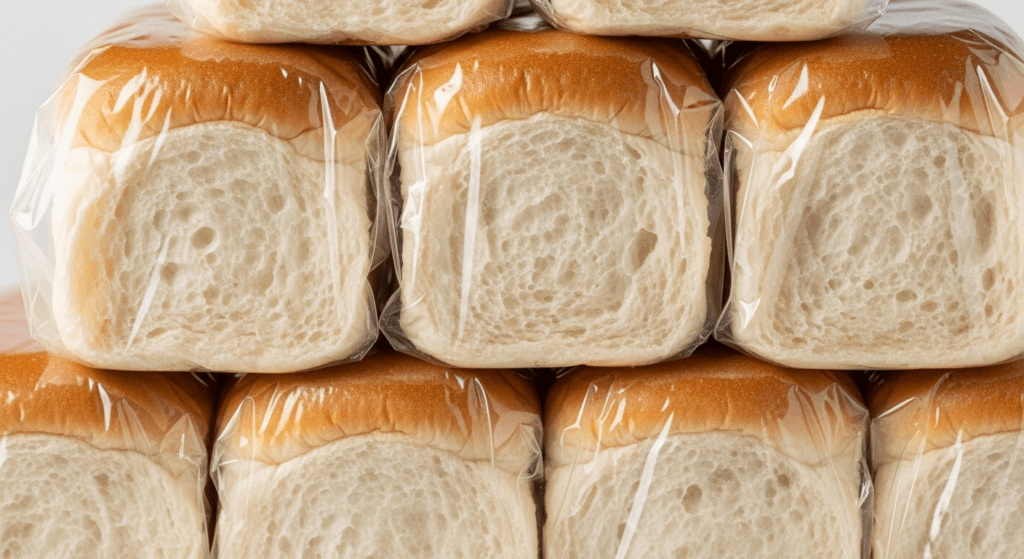
Paper Bags/Sleeves
Paper bags give bread a traditional, artisanal look that many customers prefer. Bakeries use them for fresh baguettes, sourdough loaves, and specialty breads.
These bags allow bread to breathe, preventing the crust from getting soggy. However, this also means bread stays fresh for only 1-2 days.
Most paper bread bags are made from 40-50 pound kraft paper. Many feature windows made from cellophane or plastic so customers can see the product. They’re also recyclable and compostable, appealing to eco-conscious shoppers.
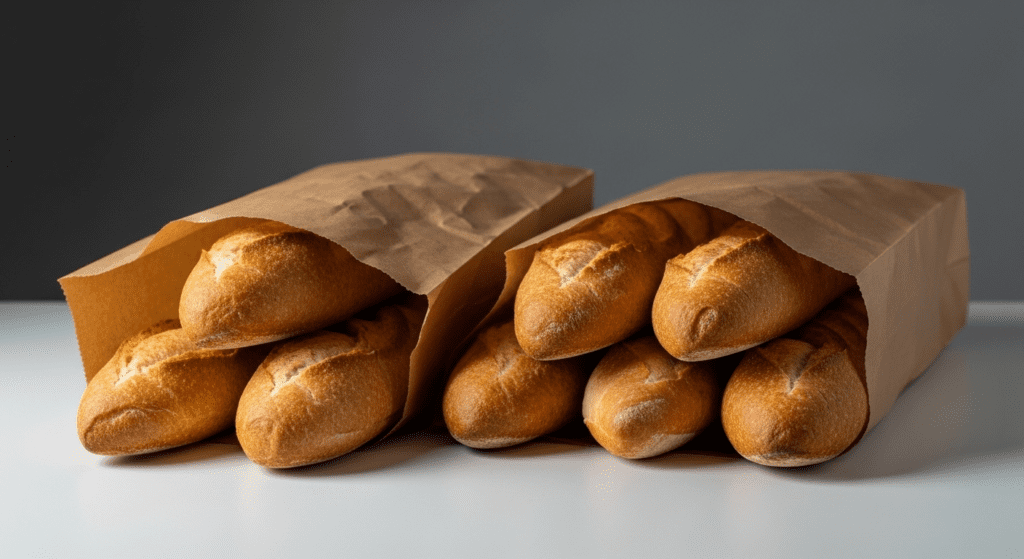
Boxes and Cartons
Cardboard boxes protect delicate breads like croissants, Danish pastries, and specialty loaves. The rigid structure prevents crushing during transport.
These packages often combine a cardboard base with a plastic window on top. This design showcases the product while providing maximum protection.
Boxes keep bread fresh for 3-4 days when lined with wax paper or plastic. They also stack easily in delivery trucks and on store shelves.
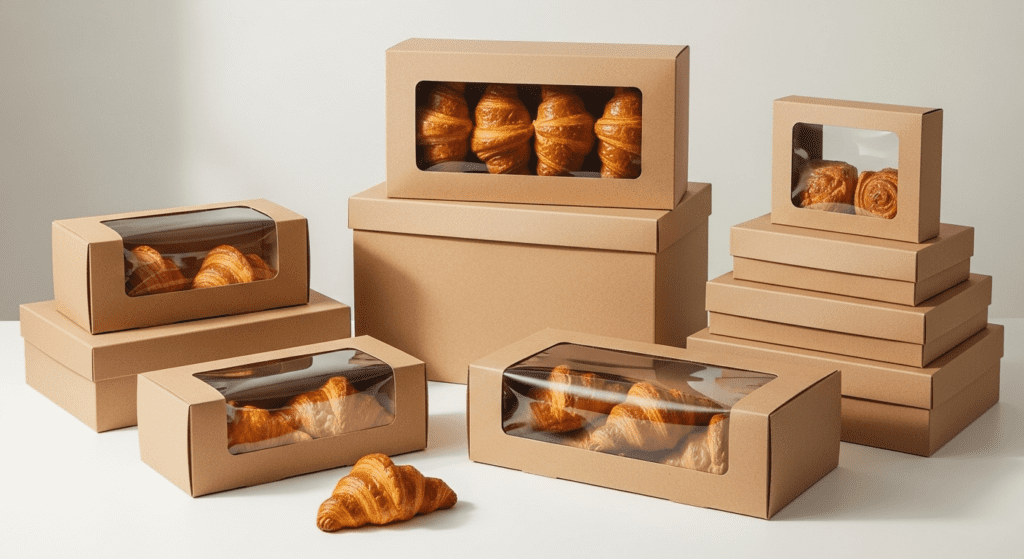
Clamshell/Tray Packaging
Clamshell containers have a hinged lid that snaps shut, creating a protective shell around the bread. You’ll find them holding everything from dinner rolls to artisan cookies.
These plastic containers are usually made from PET or recycled plastic. They’re clear, letting customers see all angles of the product.
Bakeries like them because they’re tamper-evident – you can tell if someone opened the package. Items stay fresh for 4-5 days in these airtight containers.
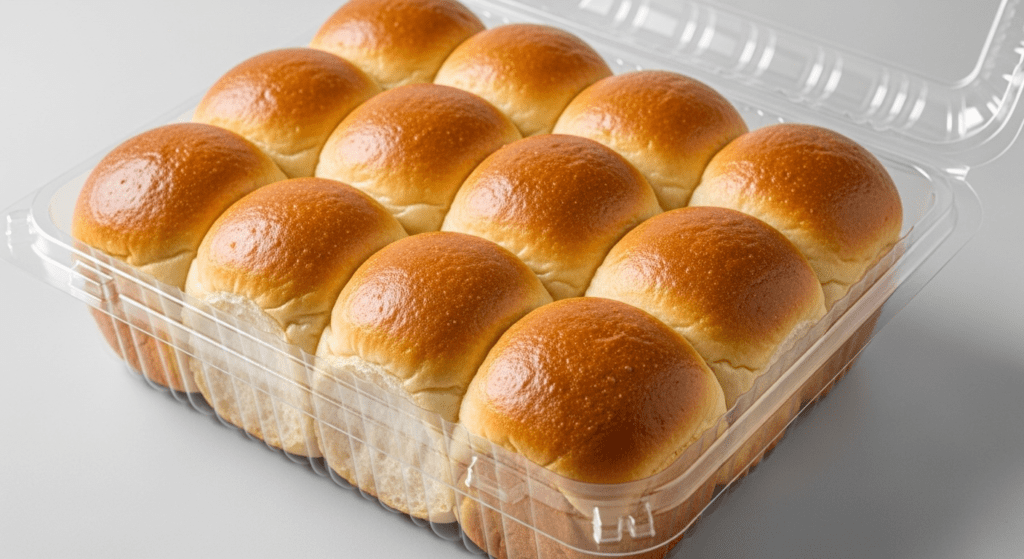
Vacuum Packs
Vacuum packaging removes all air from around the bread before sealing. This method can extend shelf life to 2-3 weeks without preservatives.
The process works best for dense breads like pumpernickel or specialty grain loaves. Soft breads can get squished by the vacuum pressure.
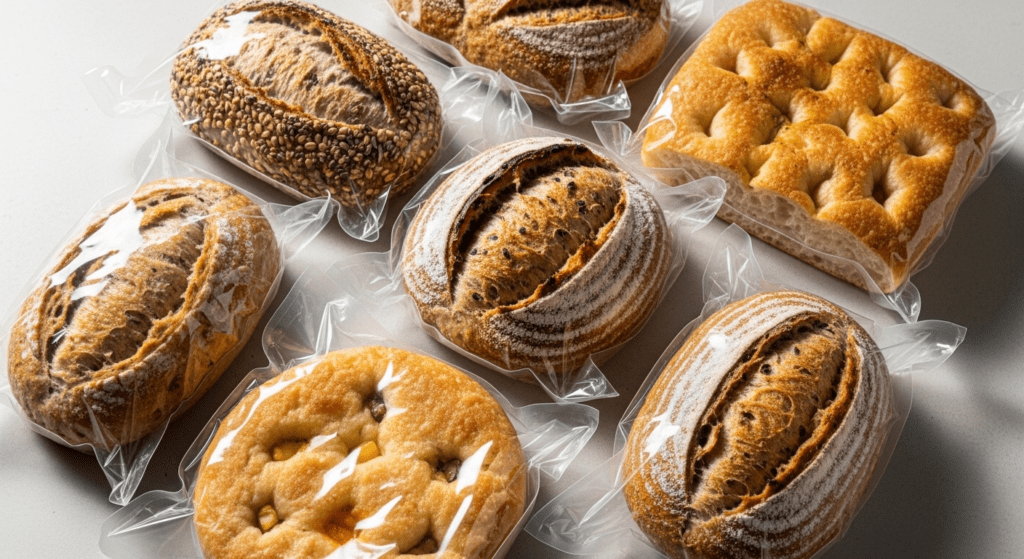
Modified-Atmosphere Packaging (MAP)
MAP replaces regular air with a special gas mixture, usually nitrogen and carbon dioxide. This slows down mold growth and staling.
Breads in MAP can last 15-21 days on the shelf. That’s three times longer than regular plastic bags.
You’ll mostly see MAP used for premium breads, tortillas, and flatbreads. The extended shelf life allows wider distribution without preservatives.
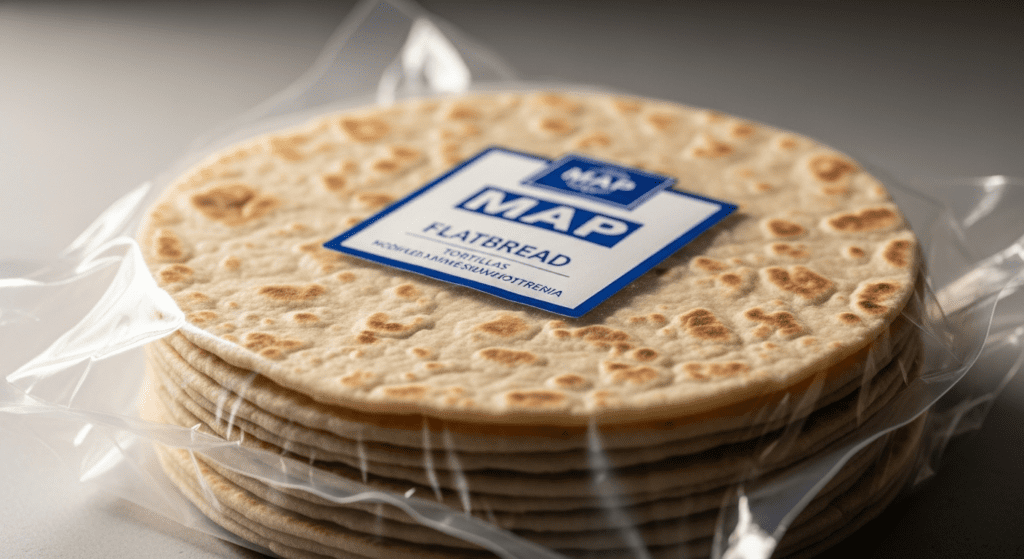
Wax/Deli Paper or Foil Wrap
Deli paper and foil wraps work great for immediate consumption items. Bakeries use them for fresh rolls, individual pastries, and sandwich breads.
Wax paper keeps bread fresh for several hours while allowing customers to handle their purchase easily.
Foil wrap works better for items with butter or oil, like garlic bread. The foil prevents grease from soaking through.
These wraps are perfect for bakery counter sales but don’t work for longer storage. Bread wrapped this way needs to be eaten within 4-6 hours.
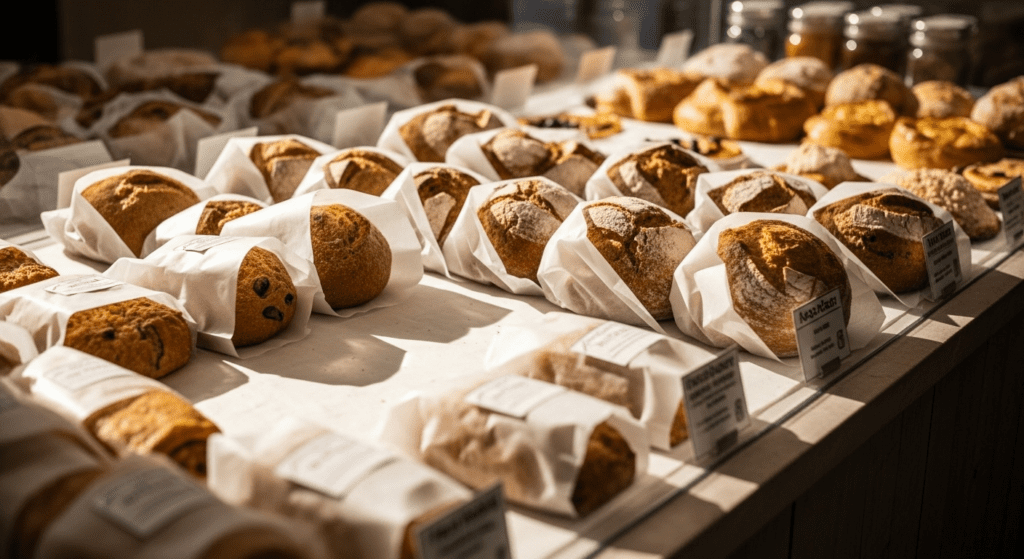
Cloth/Mesh Bags
Reusable cloth and mesh bags appeal to environmentally conscious consumers. They’re washable and can last for years with proper care.
Cotton bags keep crusty breads fresh for 2-3 days. The fabric lets moisture escape while protecting the bread from drying out completely.
Mesh bags work best for breads that need air circulation. They’re perfect for artisan loaves with thick, crunchy crusts.
Many bakeries sell them as an eco-friendly alternative to disposable packaging.
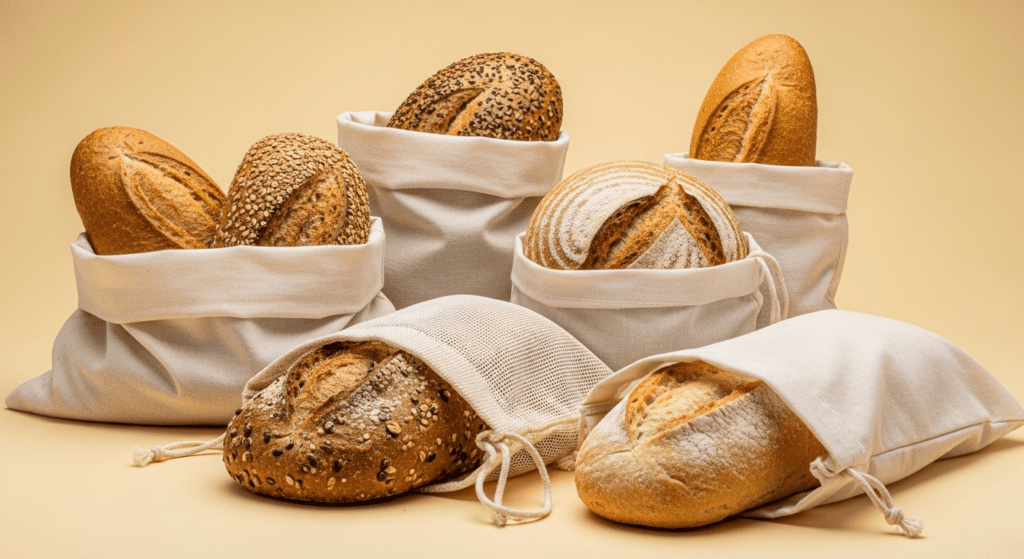
Different Breads Call for Different Packaging
| Bread Type | Best Packaging | Shelf Life | Why It Works |
|---|---|---|---|
| White/Wheat Sandwich Bread | Polyethylene bags | 5-7 days | Maintains moisture, prevents drying |
| Baguettes | Paper bags/sleeves | 1-2 days | Keeps crust crispy, allows breathing |
| Dinner Rolls | Flow-wrap or clamshell | 4-5 days | Protects shape, easy display |
| Artisan Sourdough | Paper or cloth bags | 2-3 days | Preserves crust texture |
| Croissants | Boxes with windows | 3-4 days | Prevents crushing, shows product |
| Flatbreads/Tortillas | MAP packaging | 15-21 days | Extended shelf life, no preservatives |
| Specialty Grain Breads | Vacuum packs | 14-21 days | Maximum freshness, space-saving |
| Fresh Bakery Items | Wax/deli paper | 4-6 hours | Immediate consumption, easy handling |
| Premium Loaves | Cloth/mesh bags | 2-3 days | Reusable, maintains quality |
What Is the Best Packaging to Keep Bread Fresh?
The best packaging to keep bread fresh is a paper bag for crusty bread and a plastic bag or airtight container for soft bread. Paper prevents sogginess by allowing airflow. Plastic seals in moisture to delay staling. For longer storage, freeze bread in airtight freezer bags.
What Type of Plastic Is Bread Packaging?
Bread packaging is typically made from low-density polyethylene (LDPE), labeled as recycling code #4. LDPE is lightweight, flexible, and moisture-resistant, making it ideal for keeping bread fresh while reducing air exposure. Some bread bags may also include polypropylene (PP) for added clarity and durability.
Are Bread Bags Freezer Safe
Most commercial bread bags made of polyethylene are freezer safe and can store bread for up to 3 months. Use a second layer, like aluminum foil or a freezer-safe plastic bag, to prevent freezer burn. Avoid using paper bread bags in the freezer as they allow moisture and air to penetrate.

